Mirella Sichirollo Patzer's Blog, page 35
October 4, 2012
Those Scandalous Etruscan Women
Those Scandalous Etruscan
Women
By
Barbara Lambert
Author
The Whirling Girl
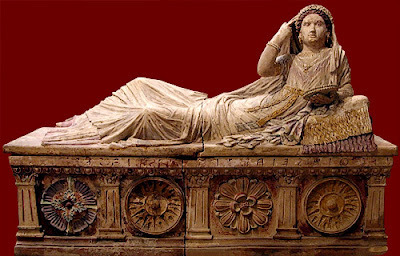
If there were a
prize for getting unfairly bad-mouthed in ancient history, Etruscan women would
likely win hands down. The Greeks and later Romans said terrible things about
them: lascivious, lewd, sybaritic, totally out of control. Imagine! Etruscan
women “attended banquets” where they “sat under the same blankets as their
husbands!” – a behavior that had them compared to hetairai (basically courtesans or prostitutes: the only women allowed
at Greek parties). Even Aristotle
tut-tutted.
Not only did Etruscan wives scandalously
go out in public -- and entertain lavishly, wear glorious jewellery, indulge a clothing
sense that is recorded in frescos, statuary, and the bronze mirrors etched with
sometimes rather racy scenes that give us fascinating detail of how fashion
changed down the centuries – but they also learned to read and write. (We know
the danger of that!) They were rumored to raise
their own children, too. Presumably
passing along the dire literary habit.
Before
the rise of Rome as a super power, the Etruscans ruled almost the whole of
Italy. Their ships dominated the surrounding seas. Fearsome enough, as news of
them spread abroad, without the added queasiness of hearing how Etruscan society
accorded women influence and power.
Hard to say where
this all started. With Tanaquil? Who used her soothsaying powers to persuade her
Etruscan husband, Lucius Tarquin, that he could become the first Etruscan king
of Rome?
Or
maybe the bad rap began with Tullia, her successor, who arranged a series of
murders to keep the dynasty in the family -- finally convincing her husband that
her own father should be murdered, then publicly driving her chariot over his
body to make sure. This ruthless streak was passed along to the third of the Tarquin
kings, Tarquin the Proud, whose son finally brought down the dynasty with the
infamous “rape of Lucretia”. After that, the Etruscan Tarquins were driven from
Rome, and a Republic was established.
Granted,
the Tarquins turned out to be an overbearing lot (though responsible for any
number of remarkable advancements in the Rome). But surely it’s unfair for the
whole of Etruscan womanhood to be tainted by their extremes.
One of the reasons
that the Etruscans, in general, gained a reputation for libertine excesses is
that none of their literature survives. Their enemies got the last word in,
literally. At least, until archaeology came along to tell a different story.
We know, now, that women in Etruria were
accorded dignity and respect, right across the spectrum of family and public
and religious life. And speaking of those children, whom so scandalously they
“raised”, there are many statues, carvings and ex-votos, large and small,
showing images of women not just raising, but breast-feeding their children – images
so like Medieval and Renaissance depictions of “Madonna and Child” that it’s
hard not to wonder at their influence on the great masterpieces of later
Italian religious art.
So yes, they loved to party – but even
in lavish “elite” tombs, their favorite things to take along to the after life included
loom weights, spindle-whorls, and much further evidence of dedication to the home
based industries that made such a major contribution to their society’s
commercial wealth.
Still, they were scandalous, these Etruscan women. They rode horses (shockingly,
“astride”, as recent analysis of a female skeleton has affirmed); some even had
their own chariots (discovered buried with them in their graves); and unlike
Roman women who had no names of their own (but were known just as their fathers’
daughters or their husbands’ wives) Etruscan women passed on both name and rank
to their children, along with distinct legal rights. Not only did they own their
names, but they had a distinct sense of ownership
of their bodies – as excavation of Etruscan “healing sanctuaries” has revealed,
where miniature bronze or terracotta reproductions of the most intimate female
body parts have been discovered, along with other votive offerings.
No wonder they were tut-tutted at. What
a threat they truly must have seemed, to other “decently ordered” cultures of
the ancient world. Across society at large, their like was not seen again till modern
times.
And
even now – ah, even now!
But
that is another story.
Visit Barbara Lambert!
I LOVE COMMENTS

From History and Women










Women
By
Barbara Lambert
Author
The Whirling Girl

If there were a
prize for getting unfairly bad-mouthed in ancient history, Etruscan women would
likely win hands down. The Greeks and later Romans said terrible things about
them: lascivious, lewd, sybaritic, totally out of control. Imagine! Etruscan
women “attended banquets” where they “sat under the same blankets as their
husbands!” – a behavior that had them compared to hetairai (basically courtesans or prostitutes: the only women allowed
at Greek parties). Even Aristotle
tut-tutted.
Not only did Etruscan wives scandalously
go out in public -- and entertain lavishly, wear glorious jewellery, indulge a clothing
sense that is recorded in frescos, statuary, and the bronze mirrors etched with
sometimes rather racy scenes that give us fascinating detail of how fashion
changed down the centuries – but they also learned to read and write. (We know
the danger of that!) They were rumored to raise
their own children, too. Presumably
passing along the dire literary habit.
Before
the rise of Rome as a super power, the Etruscans ruled almost the whole of
Italy. Their ships dominated the surrounding seas. Fearsome enough, as news of
them spread abroad, without the added queasiness of hearing how Etruscan society
accorded women influence and power.
Hard to say where
this all started. With Tanaquil? Who used her soothsaying powers to persuade her
Etruscan husband, Lucius Tarquin, that he could become the first Etruscan king
of Rome?
Or
maybe the bad rap began with Tullia, her successor, who arranged a series of
murders to keep the dynasty in the family -- finally convincing her husband that
her own father should be murdered, then publicly driving her chariot over his
body to make sure. This ruthless streak was passed along to the third of the Tarquin
kings, Tarquin the Proud, whose son finally brought down the dynasty with the
infamous “rape of Lucretia”. After that, the Etruscan Tarquins were driven from
Rome, and a Republic was established.
Granted,
the Tarquins turned out to be an overbearing lot (though responsible for any
number of remarkable advancements in the Rome). But surely it’s unfair for the
whole of Etruscan womanhood to be tainted by their extremes.
One of the reasons
that the Etruscans, in general, gained a reputation for libertine excesses is
that none of their literature survives. Their enemies got the last word in,
literally. At least, until archaeology came along to tell a different story.
We know, now, that women in Etruria were
accorded dignity and respect, right across the spectrum of family and public
and religious life. And speaking of those children, whom so scandalously they
“raised”, there are many statues, carvings and ex-votos, large and small,
showing images of women not just raising, but breast-feeding their children – images
so like Medieval and Renaissance depictions of “Madonna and Child” that it’s
hard not to wonder at their influence on the great masterpieces of later
Italian religious art.
So yes, they loved to party – but even
in lavish “elite” tombs, their favorite things to take along to the after life included
loom weights, spindle-whorls, and much further evidence of dedication to the home
based industries that made such a major contribution to their society’s
commercial wealth.
Still, they were scandalous, these Etruscan women. They rode horses (shockingly,
“astride”, as recent analysis of a female skeleton has affirmed); some even had
their own chariots (discovered buried with them in their graves); and unlike
Roman women who had no names of their own (but were known just as their fathers’
daughters or their husbands’ wives) Etruscan women passed on both name and rank
to their children, along with distinct legal rights. Not only did they own their
names, but they had a distinct sense of ownership
of their bodies – as excavation of Etruscan “healing sanctuaries” has revealed,
where miniature bronze or terracotta reproductions of the most intimate female
body parts have been discovered, along with other votive offerings.
No wonder they were tut-tutted at. What
a threat they truly must have seemed, to other “decently ordered” cultures of
the ancient world. Across society at large, their like was not seen again till modern
times.
And
even now – ah, even now!
But
that is another story.
Visit Barbara Lambert!
I LOVE COMMENTS

From History and Women









Published on October 04, 2012 06:10
September 30, 2012
The Whirling Girl by Barbara Lambert

Caught in a net of her own lies …
When botanical artist Clare Livingstone unexpectedly inherits her uncle’s property in Tuscany, she travels to Italy to learn why—despite their estranged relationship and complicated past—she was chosen to maintain his legacy.
The hill town of Cortona, however, won’t give up its secrets easily. Clare is immediately plunged into intrigue. Two men pursue her, but with agendas of their own, neighbours try to delve into the story of her past and unscrupulous archaeologists are drawn to her property in search of buried Etruscan artefacts. Once again forced to negotiate between desire and history— in a balance as fragile as the orchids she illustrates for science—Clare realizes she cannot escape her life of deception until she finally confronts the truth she has kept buried so long.
The Whirling Girl by award winning author Barbara Lambert is a treat for the senses. It is the story of Clare Livingstone, a young painter of exotic flowers, whose estranged uncle has left her a property in Tuscany where Etruscan artefacts are buried. Like the long buried treasures, Clare also has buried some secrets of her own. Soon she finds herself caught between archaeologiests and anthropologists who are sabotaging each other to get their hands on the treasure, along with a host of other colorful villagers, neighbours, and other characters with agendas and secrets of their own. As the secrets buried beneath the earth are revealed, so are her own darkest secrets, which she must come to terms with.
Brilliant, meaningful prose can be found on each and every page of this fascinating, complex novel. Add to that, wonderful detailed descriptions of the lush Italian surroundings and rich culture, and you will find plenty to love about this novel. Because of its depth and complexity, yet with an easy to read prose, it is a novel to read slowly and enjoy to its fullest, just like as if you were leisurely sipping a fine wine. Humor, sadness, mystery, love, and loss all meld together to make an engrossing read. This is one novel not to miss.
I LOVE COMMENTS

From History and Women









Published on September 30, 2012 23:14
September 25, 2012
The Twelve Rooms of the Nile by Enid Shomer
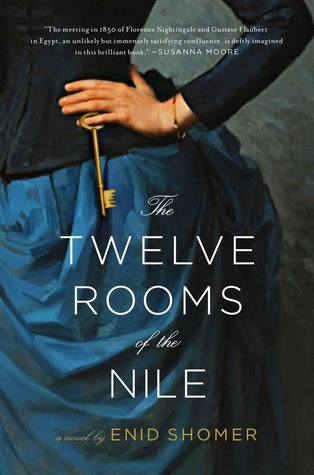
Before she became the nineteenth century’s greatest heroine, before he had written a word of Madame Bovary, Florence Nightingale and Gustave Flaubert traveled down the Nile at the same time. In the imaginative leap taken by award-winning writer Enid Shomer’s The Twelve Rooms of the Nile, the two ignite a passionate friendship marked by intelligence, humor, and a ravishing tenderness that will alter both their destinies.
In 1850, Florence, daughter of a prominent English family, sets sail on the Nile chaperoned by longtime family friends and her maid, Trout. To her family’s chagrin—and in spite of her wealth, charm, and beauty—she is, at twenty-nine and of her own volition, well on her way to spinsterhood. Meanwhile, Gustave and his good friend Maxime Du Camp embark on an expedition to document the then largely unexplored monuments of ancient Egypt. Traumatized by the deaths of his father and sister, and plagued by mysterious seizures, Flaubert has dropped out of law school and writ-ten his first novel, an effort promptly deemed unpublishable by his closest friends. At twenty-eight, he is an unproven writer with a failing body.
Florence is a woman with radical ideas about society and God, naive in the ways of men. Gustave is a notorious womanizer and patron of innumerable prostitutes. But both burn with unfulfilled ambition, and in the deft hands of Shomer, whose writing The New York Times Book Review has praised as “beautifully cadenced, and surprising in its imaginative reach,” the unlikely soul mates come together to share their darkest torments and most fervent hopes. Brimming with adventure and the sparkling sensibilities of the two travelers, this mesmerizing novel offers a luminous combination of gorgeous prose and wild imagination, all of it colored by the opulent tapestry of mid-nineteenth-century Egypt.
Ancient Egypt is the backdrop for this imaginative novel about two famous people, Florence Nightingale and Gustave Flaubert, author of Madame Bovary, who accidently meet and form a bond while travelling through this ancient country.
The first thing that draws the reader are the lush, beautifully written descriptions of the majestic city of Egypt with the flowing Nile river, its ancient tombs, hidden artefacts, and spectacular views. The author describes the characters’ surroundings with such vividness, that it is easy to picture all the sights and feels as if one can place themselves in the actual locations.
The characters contrast each other, providing interest as the story unfolds. First there is the virtuous Florence Nightingale, a woman with a keen interest in learning, reading, who is eager to escape the restrictions of her family and society. Flaubert is depicted as a lustful, regularly immoral womanizer, Gustave Flaubert.
The novel drills deep into each character’s thoughts, their past histories, their feelings in a rich examination of the human spirit and human individuality. There is humor, sadness, and the mystery of ancient Egypt’s artefacts, weaved into each page. This book is recommended for readers who prefer beautiful prose and rich detail, rather than those who are looking for a quick, spirited read. It is very much about a few moments in time where two very different people find friendship and something in common, but which never altered their lives.
I LOVE COMMENTS

From History and Women









Published on September 25, 2012 11:56
September 24, 2012
Fashion in the days of Marie Antoinette
I have always been enchanted with the 18th century - it is definitely a favourite of mine. I came across this video in my research for one of my forthcoming novels and was thrilled to see a gown that is attributed to Marie Antoinette and her seamstress Rose Bertin.
I LOVE COMMENTS

From History and Women










I LOVE COMMENTS

From History and Women









Published on September 24, 2012 11:39
September 19, 2012
The Raven's Heart by Jesse Blackadder

‘I am awaiting my castle and the Queen is waiting for love.’
Scotland, 1561
A ship carries Mary, the young Queen of Scots, home from the French court to wrest back control of her throne. Masquerading as a male crew member, Alison Blackadder must find a way to gain the Queen’s favour so she can win back her family’s castle and lands, cruelly stolen by a murderous clan a generation ago.
Surrounded by treachery and deep suspicion, the Queen can trust nobody in the Scottish court until Alison with her flair for disguise, becomes her valued confidante and spy. But Alison’s drive to reclaim the Blackadder birthright is relentless, setting off events that threaten to bring down the monarchy. Alison discovers lies, danger and betrayal at every turn. Then, unexpectedly, she finds love ...
This sweeping and imaginative tale of political intrigue, secret passion and implacable revenge is a breathtaking epic from a remarkable Australian literary talent.
Set in 16th century Scotland, The Raven's Heart is a riveting tale of intrigue, obsession, and the fight for power. It is very much a tale about two women, Alison Blackadder and Mary Stuart, Queen of Scots. They meet at Blackadder castle, an ancient fortress that rests on the shores of Blackadder Water in Berwickshire. A rumour about the castle states that when the first Blackadder swore a blood oath and sprinkled his blood into the water, men have been driven by madness in order to own it.
Alison Blackadder’s father, William, is obsessed with taking back Blackadder Castle after usurpers stole it. Assasins have been trying to kill both Alison and her father in order to keep them from claiming the castle. As a result, Alison has spent her life dressed as a boy to send the killers off their track.
When Mary Stuart was secretly returned to Scotland, Alison and her father were part of the party escorting her home. At her father’s urging, however, Alison is turned back into a girl in order to become one of the Queen’s ladys-in-waiting. But when Mary discovers Alison’s dual role as boy and girl, she tasks her with teaching her and her other ladies to secretly pass themselves off as men to gain freedom from the court’s restrictions and to preserve their identities.
This novel is filled with life and death risks, treachery, and profound love. Because of her surname, Blackadder, author Jesse Blackadder was always being asked if she was related to Rowan Atkinson, star of the BBC sitcom Blackadder. Her curiosity roused, she travelled to Scotland to Blackadder to find her roots. There, she discovered the ruins of Blackadder Castle. As she began to research, this story came to life in her imagination.
The story gives us a unique look and interpretation into the era in which Mary, Queen of Scots lived and reined. Each character is well drawn, with a depth of personality that truly makes them believable. Couple that will colorful descriptions of clothing, surroundings, and castle life, and it does make for a fascinating read. A strong lesbian undercurrent runs through the novel, which may not appeal to all readers. Nevertheless, it is a compelling, well-told tale with plenty of plot twists and excellent dialogue to keep readers interested.
I LOVE COMMENTS

From History and Women









Published on September 19, 2012 12:49
September 17, 2012
18th Century Noblewoman's Fashion
Fashion has come a long way. Most days, when around the house, you can find me in a nice roomy t-shirt and yoga pants. But in the 18th century, a woman's clothing was much more complex with numerous layers and trimmings. And then, after a woman is dressed, freedom of movement is constricted.
Here is a video I found that demonstrates the complexity noblewomen faced each morning just to get dressed.
I LOVE COMMENTS

From History and Women










Here is a video I found that demonstrates the complexity noblewomen faced each morning just to get dressed.
I LOVE COMMENTS

From History and Women









Published on September 17, 2012 11:35
September 15, 2012
Unruly Princess by Marcelle Thiébaux
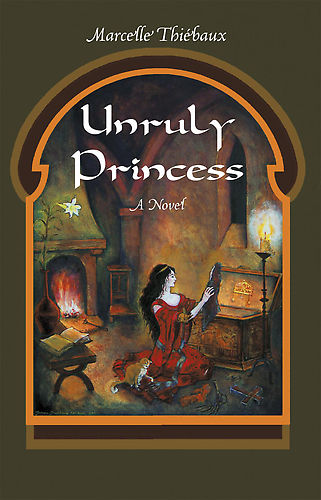
A compelling novel about Saint Margit of Hungary's defiant life.
In a vaulted chamber on the Danube, a radiant medieval princess bargains with God. How can she defy the conqueror Ottakar of Bohemia? He loves her. He's entranced by her heroic sanctity and he wants this glorious, headstrong girl for his queen. Willful Margit refuses him and scorns her regal duties. She wears her sumptuous gowns to rags, vowing to live as a penitent and the Hungarian kingdom's spiritual defender. Meanwhile the beguiling Princess Cunegonda, a widow of fifteen, covets the handsome warrior prince and makes a fervent bid for him. The two impetuous royal girls and the ambitious crusader hero are caught up in an unexpected triangle. One princess is consumed by divine ardor, the other is inflamed by songs of the silken dalliances of courtly love. The valiant Bohemian loves both enchanting girls in turn, and confronts his destiny. A riveting historical romance springing from fact and legend, Unruly Princess weaves a tale of passion and politics, spiked by warfare, wooing and wedding.
Review:
The Unruly Princess tells the story of Saint Margit of Hungary, the daughter of a king whose kingdom was plagued by attacks by the brutal Tartars/Mongols. Desperate to bring peace to his lands and peoples, the king and queen pray to God for help. In exchange for His help, they promise to pledge their soon-to-be born 9th child to God. That child was a girl they named Margit.
The royal couple’s prayers were answered, and in keeping with their promise, pledged 3 year old Margit to a Dominican convent where she was educated with other children of the nobility. But Margit was not like the other children. She was extremely pious and dedicated every moment of her life serving God. She demanded to wear nun’s clothing instead of her rich garments. She fasted, wore hairshirts, took on the dirtiest, hardest tasks of the convent, did laundry, prepared food for others, prayed throughout the night, tended to the most sick and vile, and wore the most ragged of clothes. To pledge her body and soul to God brought her the greatest joy and she yearned to one day take the vows to become a nun. But her family had other plans for this royal princess and they arranged a lucrative marriage for their daughter. Margit was incensed for she had been pledged to God even before she was born and refused to consider any other path for her life.

Detailed hagiographies are hard to find, but Dr Marcelle Thiébaux has managed to take fact and blend it beautifully into fiction. Although this is fiction, it has been meticulously researched and is strongly based on the actual details of Saint Margit’s life. It is an ambitious but small hagiography that packs a powerful punch. This intriguing story about a young girl’s ambition to defiantly follow her heart and calling kept me interested from start to finish. Saint Margit is beautifully characterized, believable, real, and compelling. I especially enjoyed the setting of medieval Hungary. I hope that Dr Marcelle Thiébaux will write other fictionalized hagiographies. The stories of saints are always fascinating because of the terrible conflicts they faced and overcame. This one is no exception. Highly recommended.

I LOVE COMMENTS

From History and Women









Published on September 15, 2012 09:42
September 13, 2012
Freud's Sister by Goce Smilevski
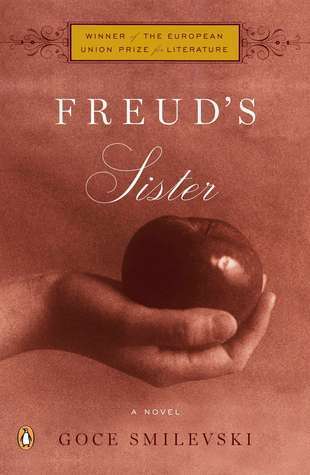
The award-winning international sensation that poses the question: Was Sigmund Freud responsible for the death of his sister in a Nazi concentration camp?
The boy in her memories who strokes her with the apple, who whispers to her the fairy tale, who gives her the knife, is her brother Sigmund.
Vienna, 1938: With the Nazis closing in, Sigmund Freud is granted an exit visa and allowed to list the names of people to take with him. He lists his doctor and maids, his dog, and his wife's sister, but not any of his own sisters. The four Freud sisters are shuttled to the Terezín concentration camp, while their brother lives out his last days in London.
Based on a true story, this searing novel gives haunting voice to Freud's sister Adolfina—“the sweetest and best of my sisters”—a gifted, sensitive woman who was spurned by her mother and never married. A witness to her brother's genius and to the cultural and artistic splendor of Vienna in the early twentieth century, she aspired to a life few women of her time could attain.
From Adolfina's closeness with her brother in childhood, to her love for a fellow student, to her time with Gustav Klimt's sister in a Vienna psychiatric hospital, to her dream of one day living in Venice and having a family, Freud's Sister imagines with astonishing insight and deep feeling the life of a woman lost to the shadows of history.
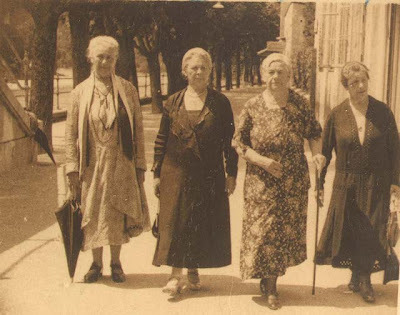
Sigmund Freud's Sisters
Adolfina Freud was the youngest of Sigmund Freud’s sisters. Sickly and shunned by an unloving mother who keeps telling her she should never have been born, Adolfina develops a strong bond with her eldest brother whom she adores. He shelters her and loves her as they grow into adulthood. Sigmund marries and becomes successful. His work into mental illness gains acclaim and his career reaches loftier heights, bringing much distance in his relationship with his sister. Adolfina’s life, on the other hand, begins a downward spiral that plummets her into madness and depression, and ultimately institutionalized for a period.

Sigmund Freud
As World War II heats up, and the Nazi’s seize control of Austria, Sigmund, because of his career, has the paperwork necessary to flee the country with members of his family. He takes his wife and even his dog, but does nothing for his sisters. Sigmund ignores their please to get them out of the country and ultimately results in their capture and execution in the gas chambers at Terezin.
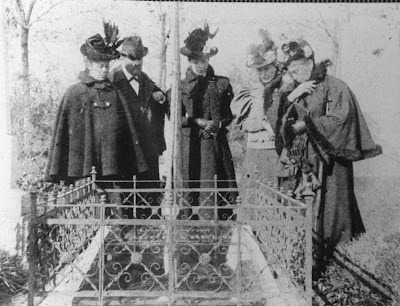
Freud, his mother, and his sisters looking into their father's grave
This is a very complex, and emotionally moving book, which left me feeling a bit unsettled as to Sigmund’s behavior with Adolfina, at times treating her experimentally and coldly like a test subject and at other times, treating her like a beloved sister. I had trouble understanding why Sigmund would deliberately leave his family in Austria under threat of the Nazis when he had the means to save them, but no one but Sigmund Freud will ever be able to answer that question. It is for these very reasons that this novel is so captivating, so haunting, so fascinating, and so richly deserves the prestigious international award and all the attention it has garnered.
I LOVE COMMENTS

From History and Women









Published on September 13, 2012 09:21
September 12, 2012
The Gilded Lily Book by Deborah Swift - BOOK TOUR

A spellbinding historical novel of beauty and greed, and surprising redemption.
England, 1660. Ella Appleby believes she is destined for better things than slaving as a housemaid and dodging the blows of her drunken father. When her employer dies suddenly, she seizes her chance--taking his valuables and fleeing the countryside with her sister for the golden prospects of London. But London may not be the promised land she expects. Work is hard to find, until Ella takes up with a dashing and dubious gentleman with ties to the London underworld. Meanwhile, her old employer's twin brother is in hot pursuit of the sisters.
Set in a London of atmospheric coffee houses, gilded mansions, and shady pawnshops hidden from rich men's view, Deborah Swift's The Gilded Lily is a dazzling novel of historical adventure.
Book Review
The Gilded Lily by Deborah Swift is a companion novel to The Lady’s Slipper and continues the story of Ella Appleby.
In 1661, Ella is working as a maid for a wealthy gentleman. When she finds him dead, she steals numerous valuables from the home, grabs her sister Sadie, who has a large red birthmark on her face, and they flee to London to start a new life. But life there proves to be harder than the life they left behind. Soon, wanted-posters begin to appear and a hefty reward is offered for the capture of the two sisters. The sisters find work in a wig-making shop, but Ella soon loses her job there and comes to the attention of Jay Whitgift. Whitgift is a notorious pawnbroker who runs a clandestine theft ring. When he decides to set up a womans’ ladies beauty salon, he chooses Ella to work there. This causes discord between the two sisters, forcing Ella to make harsh decisions in order to avoid being identified and captured.
Deborah Swift’s latest novel is one that will grab your interest from first page to last. This dark novel sweeps the reader into London’s poorest areas to show the desperation and hardships of the poor and middle class people in their day-to-day lives. The plot is gripping with plenty of twists and turns to keep readers interested.
The characters are beautifully developed and three-dimensional. Each character has their own struggles to overcome as circumstances force them to do things and change in ways they would never have dreamed of. Ella makes some cruel decisions, yet not to the extent where the reader will despise her. Rather, although her actions are unpalatable, readers can understand her motivations clearly. There are plenty of villains too. Jay Whitgift and his circle of friends are criminals of the worst sort – exploiting and debauching innocent girls, thievery, gambling, and even murder.
The entertainment value of this novel is extremely high, the storyline fascinating, the characters memorable. I highly recommend this book and look forward to reading Deborah Swift’s next book.
I LOVE COMMENTS

From History and Women









Published on September 12, 2012 06:22
Moll Davis - The Impertinent Mistress
We are celebrating author Deborah Swift and her newest novel, The Gilded Lily today!
I invited Deborah to write about one of her favourite women of history. She chose Moll Davis, a fascinating mistress to the king in the 17th century. Sit back and enjoy this wonderful biography.
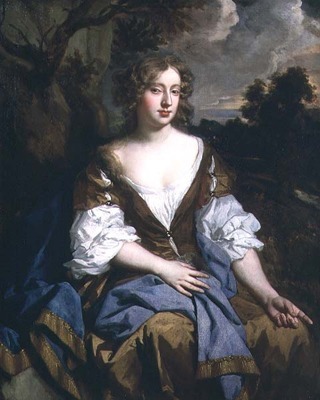
Moll Davis
The Impertinent Mistress
By
Deborah Swift
Author
of
The Lady's Slipper
and
The Gilded Lily
December 21st 1668
“It vexed me to see Moll Davis, in the box over the King’s and my Lady Castlemayne’s head, look down upon the King, and he up to her; and so did my Lady Castlemayne once, to see who it was; but when she saw her, she looked like fire; which troubled me.”
Thus wrote Pepys, spotting the rivalry between two of the King’s mistresses, the well-bred Lady Castlemaine and Moll Davis, the upstart actress.
In the seventeenth century a royal wife would be chosen for political reasons rather than as a love-match. So following the restoration of Charles II to the throne of England, and the subsequent demise of Puritanism, it is hardly surprising that Charles should have taken not one, but many mistresses. However, even by the permissive standards of the day, Charles was an extraordinarily vigorous monarch when it came to women. He made no secret of his fourteen illegitimate children, which horrified the remaining Puritans who railed against him as 'that great enemy of chastity and marriage'.
Little is known of Mary (Moll) Davis’s early life. Some asserted she was one of Lord Berkshire’s illegitimate children, though others believe she was the daughter of a blacksmith on the Earls of Berkshire’s estate in Wiltshire. From poor beginnings Moll rose to fame and fortune through the theatre. Women’s parts had previously been played by boys, so women in the theatre were immensely popular, particularly brunettes. Often they were asked to play a part where they had to disguise themselves as a boy, thus providing a convenient excuse for showing off shapely legs in a pair of hose. The new spirit of gaiety and loose-living of the Restoration brought theatre back into the public imagination. In The Gilded Lily, set during this period, Ella is auditioned by the King’s men, rivals to the Duke’s company, for the new theatre on Vere Street. Perhaps if things had gone differently for her, she might have followed in Moll’s footsteps and become a King’s mistress, for Charles did not care about rank or family where his mistresses were concerned. A pretty face and good legs were enough.
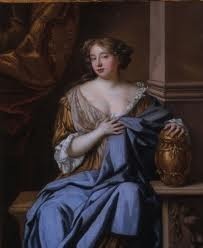
After the King asked to meet Moll, it is thought that she was introduced to the King in a coffee house, and by 1668 she was an acknowledged royal mistress.
On 11th January Pepys recorded that “Miss Davis is for certain going away from the Duke's house, the king being in love with her, and a house is taken for her and furnishing; and she hath a ring given her already worth £600.”
This picture of Moll by the court painter Peter Lely shows her holding the symbolic gold unguent jar of Mary Magdalene, so implying she is a reformed sinner, although I have to say her décolletage doesn’t exactly convince the viewer of her repentance!
Charles lavished expensive gifts on his new mistress, including a fine coach. When she became pregnant Moll gave up the stage and delivered a healthy daughter, who was to become the famous Lady Mary Tudor. Moll was one of the most renowned women of her day, though as the King’s Mistress not universally liked, and she only fell from the King’s affections when he became besotted by Nell Gwynne. In fact Samuel Pepys’s wife called her “the most impertinent slut in the world.”
Hearing that Moll was going to sleep with the king, Nell invited her to eat some sweetmeats she had prepared. Unknown to Moll, her rival had spiked the food with the laxative jalap, with the foreseeable inconvenient effect. Nell Gwynne took Moll’s place, and she must have pleased His Majesty as this event led to Moll’s fall from favour. Eventually Moll was paid off with a pension of £1,000 a year and a house in Suffolk Street. By 1673 she had bought a new house in St James Square, and later in her life after Charles’s death, she married the composer James Paisible and for a time resided at the court of the exiled James II in France.
Sir George Etherege wrote scornfully of this later marriage: "Mrs Davies has given proof of the great passion she always had for music, and Monsieur Peasible has another bass to thrum than that he played so well upon."
Moll Davis returned to London in 1693, and died in 1708, in Soho.
The effect of the King’s behaviour and the tone he set at court cannot be underestimated. What the King did, the population imitated, and many rakes and scoundrels began to emulate him and his ‘fast set’ by forming into small bands who would go about the town intent on seduction and worse. What better place could I choose to place my innocent country girls, than into this atmosphere of hedonism and danger?
Bibliography:
Diary of Samuel Pepys
Constant Delights, Rakes Rogues & Scoundrels in Restoration England – Hopkins
The Play of Personality in the Restoration Theatre – Masters
A Gambling Man, Charles II and the Restoration – Uglow
Wikipedia
The Gilded Lily

Winter, 1661. In her short life Sadie Appleby has never left rural Westmorland. But one night she is rudely awoken by her older and bolder sister, Ella. She has robbed her employer and is on the run. Together the girls flee their home and head for London, hoping to lose themselves in the teeming city. But the dead man's relatives are in pursuit, and soon a game of cat and mouse ensues amongst the freezing warren that is London in winter. Ella is soon seduced by the glitter and glamour of city life and sets her sights on the flamboyant man-about-town, Jay Whitgift, owner of a beauty parlour for the wives of the London gentry. But nothing in the capital is what it seems, least of all Jay Whitgift. Soon a rift has formed between Ella and Sadie, and the sisters are threatened by a menace more sinister than even the law. Set in a brilliantly realised Restoration London, The Gilded Lily is a novel about beauty and desire, about the stories we tell ourselves, and about how sisterhood can be both a burden and a saving grace.
'Deborah Swift's THE GILDED LILY is a heart-rending story of two sisters on the run, searching for a better life. Beautifully written and meticulously researched, the novel drew me straight into the teeming streets of Restoration London. An addictive, page-turning read.’ Mary Sharratt
Deborah Swift Blog
Deborah Swift Website
The Gilded Lily - Amazon UK
The Gilded Lily - Amazon US
I LOVE COMMENTS

From History and Women










I invited Deborah to write about one of her favourite women of history. She chose Moll Davis, a fascinating mistress to the king in the 17th century. Sit back and enjoy this wonderful biography.

Moll Davis
The Impertinent Mistress
By
Deborah Swift
Author
of
The Lady's Slipper
and
The Gilded Lily
December 21st 1668
“It vexed me to see Moll Davis, in the box over the King’s and my Lady Castlemayne’s head, look down upon the King, and he up to her; and so did my Lady Castlemayne once, to see who it was; but when she saw her, she looked like fire; which troubled me.”
Thus wrote Pepys, spotting the rivalry between two of the King’s mistresses, the well-bred Lady Castlemaine and Moll Davis, the upstart actress.
In the seventeenth century a royal wife would be chosen for political reasons rather than as a love-match. So following the restoration of Charles II to the throne of England, and the subsequent demise of Puritanism, it is hardly surprising that Charles should have taken not one, but many mistresses. However, even by the permissive standards of the day, Charles was an extraordinarily vigorous monarch when it came to women. He made no secret of his fourteen illegitimate children, which horrified the remaining Puritans who railed against him as 'that great enemy of chastity and marriage'.
Little is known of Mary (Moll) Davis’s early life. Some asserted she was one of Lord Berkshire’s illegitimate children, though others believe she was the daughter of a blacksmith on the Earls of Berkshire’s estate in Wiltshire. From poor beginnings Moll rose to fame and fortune through the theatre. Women’s parts had previously been played by boys, so women in the theatre were immensely popular, particularly brunettes. Often they were asked to play a part where they had to disguise themselves as a boy, thus providing a convenient excuse for showing off shapely legs in a pair of hose. The new spirit of gaiety and loose-living of the Restoration brought theatre back into the public imagination. In The Gilded Lily, set during this period, Ella is auditioned by the King’s men, rivals to the Duke’s company, for the new theatre on Vere Street. Perhaps if things had gone differently for her, she might have followed in Moll’s footsteps and become a King’s mistress, for Charles did not care about rank or family where his mistresses were concerned. A pretty face and good legs were enough.

After the King asked to meet Moll, it is thought that she was introduced to the King in a coffee house, and by 1668 she was an acknowledged royal mistress.
On 11th January Pepys recorded that “Miss Davis is for certain going away from the Duke's house, the king being in love with her, and a house is taken for her and furnishing; and she hath a ring given her already worth £600.”
This picture of Moll by the court painter Peter Lely shows her holding the symbolic gold unguent jar of Mary Magdalene, so implying she is a reformed sinner, although I have to say her décolletage doesn’t exactly convince the viewer of her repentance!
Charles lavished expensive gifts on his new mistress, including a fine coach. When she became pregnant Moll gave up the stage and delivered a healthy daughter, who was to become the famous Lady Mary Tudor. Moll was one of the most renowned women of her day, though as the King’s Mistress not universally liked, and she only fell from the King’s affections when he became besotted by Nell Gwynne. In fact Samuel Pepys’s wife called her “the most impertinent slut in the world.”
Hearing that Moll was going to sleep with the king, Nell invited her to eat some sweetmeats she had prepared. Unknown to Moll, her rival had spiked the food with the laxative jalap, with the foreseeable inconvenient effect. Nell Gwynne took Moll’s place, and she must have pleased His Majesty as this event led to Moll’s fall from favour. Eventually Moll was paid off with a pension of £1,000 a year and a house in Suffolk Street. By 1673 she had bought a new house in St James Square, and later in her life after Charles’s death, she married the composer James Paisible and for a time resided at the court of the exiled James II in France.
Sir George Etherege wrote scornfully of this later marriage: "Mrs Davies has given proof of the great passion she always had for music, and Monsieur Peasible has another bass to thrum than that he played so well upon."
Moll Davis returned to London in 1693, and died in 1708, in Soho.
The effect of the King’s behaviour and the tone he set at court cannot be underestimated. What the King did, the population imitated, and many rakes and scoundrels began to emulate him and his ‘fast set’ by forming into small bands who would go about the town intent on seduction and worse. What better place could I choose to place my innocent country girls, than into this atmosphere of hedonism and danger?
Bibliography:
Diary of Samuel Pepys
Constant Delights, Rakes Rogues & Scoundrels in Restoration England – Hopkins
The Play of Personality in the Restoration Theatre – Masters
A Gambling Man, Charles II and the Restoration – Uglow
Wikipedia
The Gilded Lily

Winter, 1661. In her short life Sadie Appleby has never left rural Westmorland. But one night she is rudely awoken by her older and bolder sister, Ella. She has robbed her employer and is on the run. Together the girls flee their home and head for London, hoping to lose themselves in the teeming city. But the dead man's relatives are in pursuit, and soon a game of cat and mouse ensues amongst the freezing warren that is London in winter. Ella is soon seduced by the glitter and glamour of city life and sets her sights on the flamboyant man-about-town, Jay Whitgift, owner of a beauty parlour for the wives of the London gentry. But nothing in the capital is what it seems, least of all Jay Whitgift. Soon a rift has formed between Ella and Sadie, and the sisters are threatened by a menace more sinister than even the law. Set in a brilliantly realised Restoration London, The Gilded Lily is a novel about beauty and desire, about the stories we tell ourselves, and about how sisterhood can be both a burden and a saving grace.
'Deborah Swift's THE GILDED LILY is a heart-rending story of two sisters on the run, searching for a better life. Beautifully written and meticulously researched, the novel drew me straight into the teeming streets of Restoration London. An addictive, page-turning read.’ Mary Sharratt
Deborah Swift Blog
Deborah Swift Website
The Gilded Lily - Amazon UK
The Gilded Lily - Amazon US
I LOVE COMMENTS

From History and Women









Published on September 12, 2012 06:20



